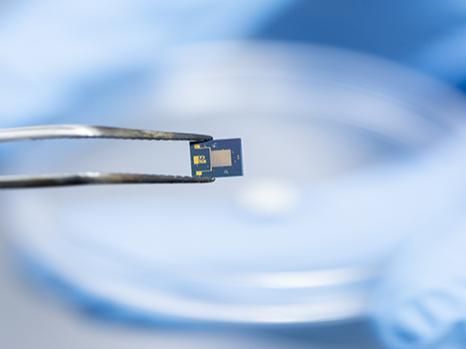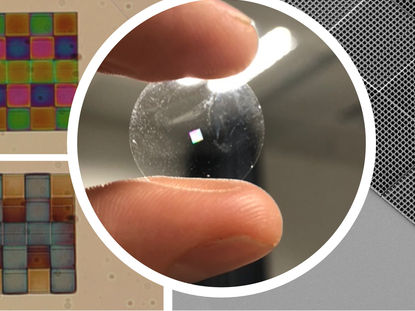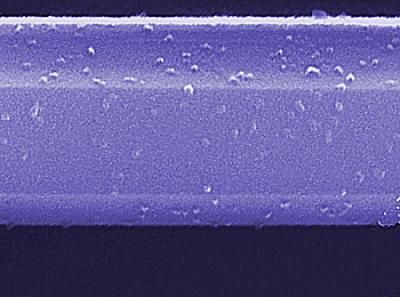MOFs can sense and sort troublesome gases
From astronauts and submariners to miners and rescue workers, people who operate in small enclosed spaces need good air quality to work safely and effectively. Electronic sensors now developed by a KAUST team can simultaneously detect at least three critical parameters that are important to monitor to ensure human comfort and safety.

This electrode is used for collecting the sensing properties of MOFs.
2019 KAUST
These new sensors use fluorinated metal-organic frameworks (MOFs) as the sensing layer. MOFs are porous materials comprising a regular array of metal atoms held together by small organic-molecule linkers to form a repeating cage-like structure. KAUST's Mohamed Eddaoudi, who led the two studies of the sensor's efficacy, explains that by altering the metal and organic components, MOFs can be tuned for applications ranging from gas separation and storage to catalysis and sensing.
"Many people have attempted to develop simple, efficient, low-cost SO2, CO2 and H2O sensors without success," say researchers Mohamed Rachid Tchalala, Youssef Belmabkhout and Prashant Bhatt, all from Eddoudi's lab.
The approach taken by Eddaoudi's group was to develop a fluorinated MOF, which Belmabkhout and Tchalala tested as sensor materials for these gases. Testing of these state-of-the-art materials was in collaboration with Khaled Nabil Salama and his team.
The first study shows how the sensor can measure the concentration of carbon dioxide and the level of humidity in the air. While the second study of the same fluorinated MOFs shows it can detect the harmful and corrosive gas sulfur dioxide, or even selectively remove it from powerplant flue gas.
"Traces of SO2 are invariably present in the flue gas produced by factories and powerplants, and SO2 can poison materials developed to trap CO2 for carbon capture and storage," say Belmabkhout and Bhatt. "AlFFIVE-1-Ni can soak up SO2 with an affinity 66 times higher than for CO2, while showing good stability to SO2 exposure."
The MOFs could also be used with two simple, low-cost high-sensitivity sensor platforms. Quartz crystal microbalance (QCM) sensors that are coated with a thin film of either MOF detected the change in mass with the absorption of SO2, or water and CO2. Similarly, MOF-coated interdigitated electrode sensors detected a change in electronic properties with the absorption of water and CO2.
Both sensor platforms, the team showed, could monitor moisture and CO2 levels under real atmospheric conditions. "The signal is calibrated against CO2 concentration, humidity level and mixtures of both," Tchalala explains. A QCM-based sensor could also detect SO2 in the air at levels of just 25 parts per million.
Original publication
Other news from the department science

Get the analytics and lab tech industry in your inbox
By submitting this form you agree that LUMITOS AG will send you the newsletter(s) selected above by email. Your data will not be passed on to third parties. Your data will be stored and processed in accordance with our data protection regulations. LUMITOS may contact you by email for the purpose of advertising or market and opinion surveys. You can revoke your consent at any time without giving reasons to LUMITOS AG, Ernst-Augustin-Str. 2, 12489 Berlin, Germany or by e-mail at revoke@lumitos.com with effect for the future. In addition, each email contains a link to unsubscribe from the corresponding newsletter.






















































